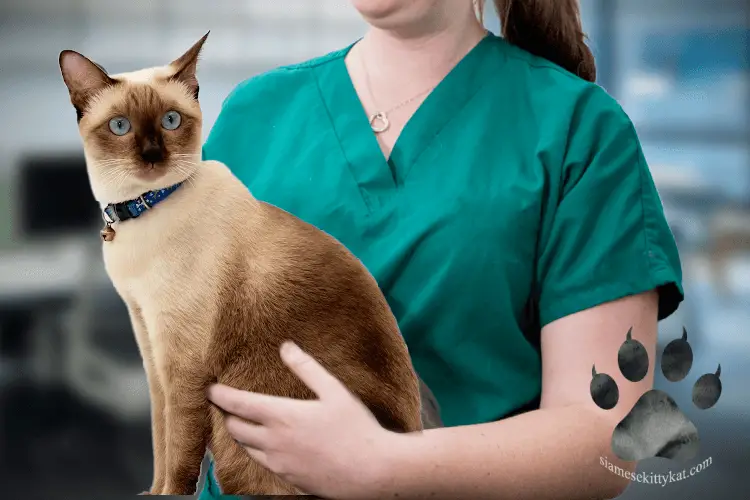A trip to the vet is one of the most important things you need to do to keep your Siamese cat healthy. He should go to the vet at least once a year. He should also go when he is sick and ill.
What if the planned vet visit is stressful for him?
A scheduled vet visit can become overwhelming and mentally taxing for your cat. The good thing is that there is much we can do to reduce their anxiety and stress.
“Preparation” is the crucial answer here.
How do you prepare your Siamese cat for a vet visit? There are three types of preparation for you to consider: the time before, during, and after the vet visit.
Taking our feline friends to the vet is stressful for them and us cat parents! That is why I plan, ensure I have enough preparation and write down my concerns and questions.
I stay calm and positive during the visit when I go to the vet well prepared.
I have tips you can follow to help prepare your Siamese kitty for his next vet visit. Keep reading!
What To Do Before the Vet Visit
1. Introduce the carrier to your cat before the vet visit.
It helps if your cat is familiar with the carrier before the scheduled appointment. This will help him see the carrier as more than a strange and frightening box.
Your cat will likely run away the first time you introduce the carrier. Keep introducing the carrier to him with the help of some tricks and treats. Be persistent and also patient! Your cat will soon be friends with the carrier after a few hard tries.
These are some of the pointers I’ve followed that helped me introduce my Siamese cats to a carrier:
2. Take your cat for a few short drives before heading out to the clinic.
Your cat will not find short or long drives scary if you take short drives with him,
You don’t have to do this often. I take my cats for a short drive once or twice a week before their next vet appointment.
You also don’t have to go far. I drive around the block and talk to my kitties for a few minutes to make them feel better about traveling.
Make him believe the trip will be enjoyable and bring you closer together. Give him treats while you do this trick so he can see that short and long trips can be fun and rewarding.
3. Consider calling a mobile vet to come to your home.
You can make an appointment for a house-call vet. I tried it a few months ago when my Siamese cat, Batman, was sick. I was too concerned that the long drive would cause him more stress and anxiety.
I called a mobile vet and was glad he took the time to visit Batman, examine him, and play with him.
Mobile veterinarians are a huge help! They can do physical examinations and provide advice in the comfort of your own home.
A trip to the vet’s clinic is necessary to have complete access to the equipment if your cat needs x-rays or surgery,
4. Be sure you are aware of the costs. Prepare and save for it.
Costs are always involved in taking care of our feline friends.
My trusted vet told me to set aside at least three months’ worth of expenses for my cat’s supplies and vet care. This way, I will not worry about these significant expenses.
Your cat may be easier to care for than other cats, but he still has expenses. According to Sound Dollar, the first trip to the vet costs between $50 and $500.
Your cat’s vet appointment fees depend on what vaccines and preventives he needs. Your vet might also recommend having your cat spayed, neutered, or flea-treated.
5. Get ready and pack the things you and your cat need.
Don’t forget to take these things with you on your trip to the vet:
What To Do During the Vet Visit

1. Ask your vet about calming supplements if your cat is anxious and stressed out.
Your cat may get anxious and stressed due to his prolonged confinement in the carrier and the long trip.
Inform your vet about your cat’s stress. Ask if there is a calming supplement or anti-anxiety medication he can provide.
Your vet will give your pet supplements with no side effects. These will relieve internal anxiety and allow him to relax during the examination.
2. Provide clear information to your vet so he can better manage your cat’s examination.
Inform your vet of any concerns or problems you have noticed with your Siamese cat. (Now is the best time to use that list you have prepared!)
Answer your vet’s questions so he knows what type of care or medication your cat needs.
3. Try to maintain as much composure and optimism as possible.
Your Siamese cat picks up on your emotional cues. He can tell what you feel because he is intelligent and empathic.
Do not appear tense during the vet visit. Your cat may become anxious and stressed too. The best thing you can do is remain calm.
What To Do After the Vet Visit
1. Talk to your cat when you get home.
Your Siamese kitty might feel nervous and disoriented when he gets home. Your voice can help him remain calm, and your stroke reassures him that he has returned home safe and sound.
2. Watch your cat’s health and condition.
Observe your Siamese cat and see if he often hides or appears withdrawn following a vet visit. Please consult your veterinarian for advice on how to deal with his anxiety and stress.
3. Pay close attention to your cat and offer some help if needed.
Your cat may feel sluggish and unsettled, so you must assist him during the long trip and ensure he’s comfortable in the carrier until you arrive home.
4. Put him somewhere warm and quiet.
Put your Siamese cat’s bed in a peaceful and warm place so he can rest well. He’ll get better fast if he sleeps in a place that makes him feel relaxed and comfortable.
5. Follow your vet’s instructions when giving medicine.
Make sure you complete the suggested course for your cat. Do not skip any medications! You must administer the medications at home as prescribed by your veterinarian.
Here are some extra tips following your cat’s vet visit:
1. Call the clinic if you have any confusion about the medication instructions.
2. Keep your cat indoors for two nights after you and your cat return from your visit.
3. Observe your cat and see if he has lost his appetite within the week. Talk to your vet if this happens.
4. Give your cat extra care to help him recover fast
5. Call your vet immediately if your cat is still not feeling well a day after the visit.
What Factors Can Make Veterinary Visits Stressful For My Siamese Cat?
A trip to the vet can be tiresome and stressful for your Siamese cat. Some factors that can make vet visits challenging for your cat are as follows:
1. Vet visit is not part of his routine. Your cat may become nervous and confused by the new activity.
2. He is away from his home and territory, which he knows well.
3. He is inside a carrier for an extended time. Being in the carrier for an extended time may stress your cat.
4. He is in a loud, running car. The unfamiliar sounds can make him feel uncomfortable throughout the trip.
5. The trip to the clinic can be challenging and tiresome, especially if it is his first time.
6. He’s going somewhere he’s never been. Your pet has no idea why he is there. It may cause him to become even more anxious.
7. He stays in the waiting room, where there are loud noises and powerful smells from many people and pets.
8. He’s led into the examination room with an unfamiliar person. He receives various treatments and care, which can be overwhelming to him.
9. He will meet the vet (a new person in his eyes), which may be frightening for your cat.
Some Siamese cats are still afraid of new people and experiences. It is a fact despite their popularity for being friendly animals. Some kitties do not socialize well. They get uncomfortable with unfamiliar people and situations.
How Do You Know If Your Siamese Cat Feels Stressed While Going To The Vet?
1. Your kitty makes much noise and meows all the time.
2. He looks nervous
3. He is crouching or squatting down
4. Your cat is purring and licking his nose
5. He is hissing and growling
6. He is throwing up.
7. He gets diarrhea.
8. He scratches the carrier too much and wants to get out.
9. He becomes less tolerant of people and gets mean when strangers get close to him.
10. He becomes aggressive when other pets are nearby.
Why Should I Use A Carrier For My Siamese Cat?

Using a carrier is the safest and most secure way to take your Siamese cat to the vet. Your kitty will feel far more secure in a carrier than being outside with you in the waiting area. Your cat will not feel bothered by other pets or people once you get to the clinic.
Why Are Regular Vet Visits Necessary?
1. Dental health issues
2. Ear infections
3. Eye issues
4. Skin infections
5. Flea infestation
6. Joint health issues
1. Your cat’s stomach using abdominal palpation
2. If your pet has any limping or muscle loss
3. Your kitty’s skin condition
4. Your pet’s heart and lungs through auscultation with a stethoscope and diagnostic testing.
1. Urinalysis – to rule out crystal formation, kidney dysfunction, and signs of diabetes
2. Fecal examination – to identify intestinal worms and to prevent parasite population growth
3. Initial blood work – to see if your cat has diabetes, anemia, or bone marrow problems
4. Lyme disease test – to check if there’s a tick infestation
5. Heartworm test – to ensure your pet is free of heartworms
To Wrap It All Up
Taking your furry pet to the vet can be exhausting and nerve-wracking for your cat if you come unprepared. Preparation makes it less likely that you and your cat will feel stressed.
Being prepared helps me stay on track throughout the vet visit. Double-check that you’ve got everything you need. List down your concerns about your cat and what you want to know.
Happy vet visit day! Thank you so much for reading! I hope this blog post helps you. Here’s hoping you and your cat have a better experience at the vet!
We gathered all the health tips tailored toward maintaining your Siamese cat’s optimal well-being. Check it out here: Siamese Cat Health: A Complete Guide

